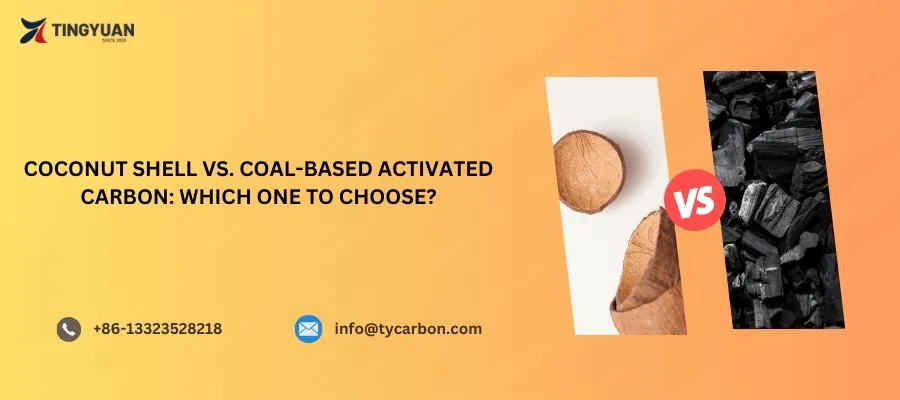Activated carbon, with its exceptional adsorption properties, plays an indispensable role in various fields such as environmental protection, healthcare, chemical industry, and food processing. Among the numerous activated carbon products, coal-based activated carbon and coconut shell activated carbon stand out as the two mainstream choices in the market due to their unique preparation processes and performance characteristics.
Although both types of activated carbon possess high adsorption capabilities, they differ significantly in terms of raw material sources, production processes, performance features, and application areas.
This article will provide an in-depth comparative analysis of coal-based activated carbon and coconut shell activated carbon, highlighting their differences to help you make a more informed choice.
What is Coconut Shell Activated Carbon?
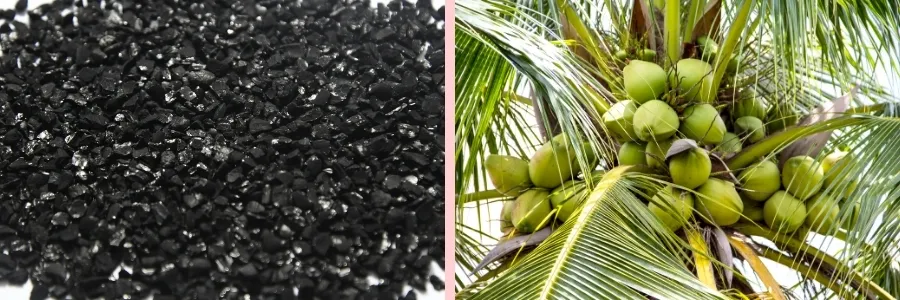
Coconut shell activated carbon is produced from coconut shells through high-temperature carbonization and activation processes. This type of activated carbon is highly regarded for its high purity, high porosity, and large surface area.
The pore structure of coconut shell activated carbon consists mainly of micropores and mesopores, which make it highly effective in adsorbing small molecules and certain organic compounds.
Coconut shell activated carbon is known for its high mechanical strength, well-developed pore structure, large surface area, fast adsorption rate, high adsorption capacity, ease of regeneration, and durability.
What is Coal-Based Activated Carbon?
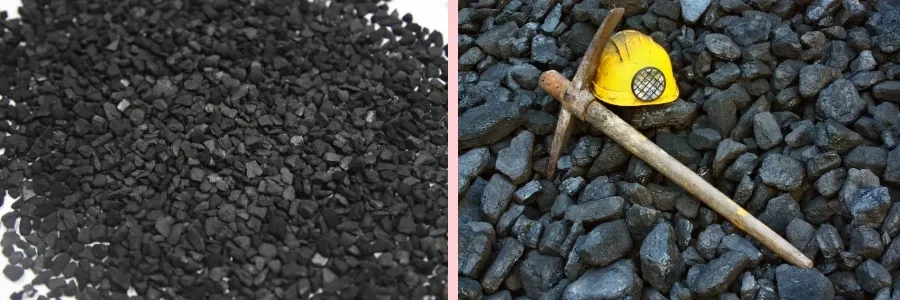
Coal-based activated carbon is produced from bituminous coal, anthracite, or lignite through carbonization and physical or chemical activation processes.
It is commonly available in three forms:
- extruded activated carbon
- granular activated carbon
- powdered activated carbon
Compared to coconut shell activated carbon, coal-based activated carbon may have a more complex pore structure, including micropores, mesopores, and macropores. It typically exhibits high mechanical strength and abrasion resistance, making it suitable for applications under high pressure conditions.
Coal-based activated carbon is characterized by its high surface area, diverse pore structure, strong adsorption capacity, high mechanical strength, and good chemical stability. It is also known for its lower production cost compared to other types of activated carbon.
Main Differences Between Coconut Shell Activated Carbon and Coal-Based Activated Carbon
Among various types of activated carbon, coconut shell activated carbon and coal-based activated carbon are often compared. While both exhibit high adsorption capabilities, they differ significantly in terms of performance, cost-effectiveness, and application areas.
Below, I will provide a detailed comparative analysis of these two types of activated carbon across three aspects:
Performance Parameter Comparison
Due to the differences in raw materials and production processes between coconut shell activated carbon and coal-based activated carbon, they exhibit significant differences in performance parameters. Understanding these differences is crucial in selecting the appropriate activated carbon for specific applications.
| Feature/Type | Coconut Shell Activated Carbon | Coal-based Activated Carbon |
|---|---|---|
| Surface Area | Large | Smaller |
| Pore Structure | Well-developed micropores | Micropores, mesopores, and macropores |
| Hardness and Wear Resistance | High | Low |
| Iodine Value | High | Low |
| Ash Content | Low, fewer impurities | High |
| Adsorption Capacity | Adsorbs small organic molecules | Adsorbs large organic molecules |
| CTC Value | High | Low |
Cost-Benefit Analysis
Coconut shell activated carbon has a higher initial cost, but in applications requiring high purity and prolonged use, its high adsorption capacity and long lifespan contribute to excellent overall economic benefits.
Although the regeneration cost is relatively high, its performance remains robust after regeneration, making it suitable for multiple reuse scenarios. Overall, its high purity and efficient adsorption capabilities provide a high cost-effectiveness in specific applications, despite the higher initial investment.
On the other hand, coal-based activated carbon offers lower initial and regeneration costs, making it suitable for large-scale industrial applications dealing with complex pollutant types such as industrial wastewater and air treatment, as well as environmental remediation. It demonstrates clear cost-effectiveness advantages in these fields.
Comparison of Application Areas
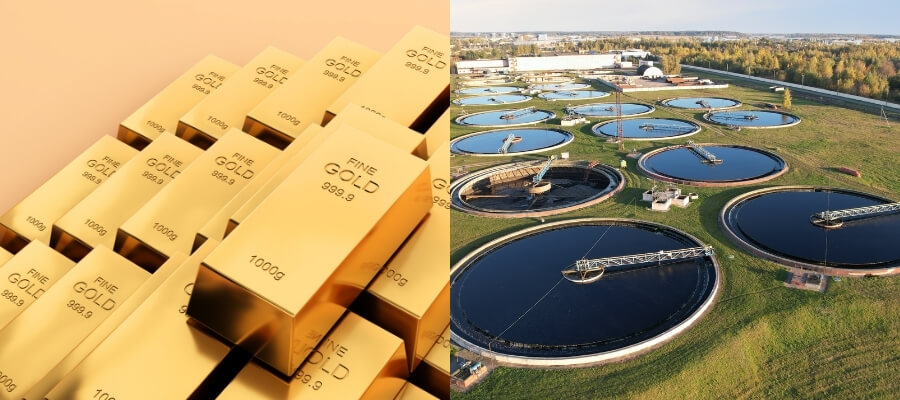
The differences in application areas between coconut shell activated carbon and coal-based activated carbon stem from their respective characteristics.
Coconut shell activated carbon, known for its high surface area and microporous structure, excels in industries such as drinking water treatment, air purification, food, and pharmaceuticals.
Coal-based activated carbon, on the other hand, with its diverse pore structure and broad-spectrum adsorption capacity, holds advantages in industrial applications such as wastewater treatment, industrial gas treatment, purification of chemical products, and environmental remediation. Below is a comparison of their different application domains:
Coconut Shell Activated Carbon:
- Drinking water treatment
- High-purity industrial wastewater treatment (food, pharmaceuticals, electronics)
- Indoor air purification (removal of VOCs, formaldehyde, benzene), efficient air filtration (laboratories, clean rooms, electronics manufacturing)
- Food and beverage industry (sugar syrup purification, beverage filtration, edible oil decolorization)
- Pharmaceutical industry (drug production purification)
- Gold refining
- Mercury removal
Coal-Based Activated Carbon:
- Industrial wastewater treatment (petrochemicals, dyes, textiles)
- Municipal wastewater treatment
- Industrial gas treatment (chemical plants, metallurgical plants, power plants)
- Automotive exhaust gas treatment
- Solvent recovery
- Alcohol and glycerin decolorization
- Groundwater remediation
- Catalyst support
- Desulfurization and denitrification
How to Choose the Right Activated Carbon for Your Needs
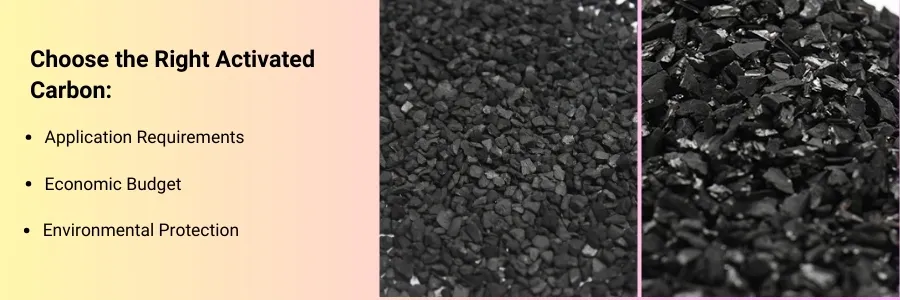
Coconut shell activated carbon and coal-based activated carbon each have their own advantages and are suitable for different applications. The choice of activated carbon should be based on specific application requirements, economic budget, and environmental impact.
Below, I will provide specific recommendations from these three aspects:
Application Requirements
- If you need to adsorb small molecular pollutants, the microporous structure of coconut shell activated carbon may be more suitable; for large molecular pollutants, the diversity of pores in coal-based activated carbon may be more advantageous.
- Consider the specific applications for which the activated carbon will be used, such as gold extraction, water treatment, air purification, etc., and choose the type of activated carbon that best suits the application.
- If the application environment requires stability across a wide pH range, coconut shell activated carbon may be more appropriate; if chemical modification is needed to improve performance, coal-based activated carbon may have more advantages.
Economic Budget
- If the budget is limited, coal-based activated carbon, due to its abundant raw materials, usually has a lower cost and may be a more economical choice.
- Consider the regenerative capacity and frequency of the activated carbon, as high-quality activated carbon can be regenerated multiple times, thereby reducing long-term costs.
Environmental Protection
- Coconut shell activated carbon, as a renewable resource, has less environmental impact and is more in line with the requirements of sustainable development.
- Consider the environmental impact of the entire life cycle of the activated carbon, from production to disposal, and choose the option with a smaller environmental footprint.
- Choose activated carbon that is easy to recycle and reuse to reduce waste generation and resource waste.
Conclusion
Coconut shell activated carbon and coal-based activated carbon have their own strengths and weaknesses due to their different properties. Choosing the right type of activated carbon based on specific application requirements, cost-effectiveness, and environmental impact can achieve the best treatment effects and sustainable development goals.
As a supplier of activated carbon, Tingyuan company are committed to providing the most suitable activated carbon products based on our customers’ specific needs, helping them to achieve the best treatment effects and cost-effectiveness in various application fields.
If you have more needs or questions, please feel free to contact us for professional advice and product support. Need to get in touch quickly? Click the email or phone number below.
- Email: info@tycarbon.com
- Phone: +86-13323528218

